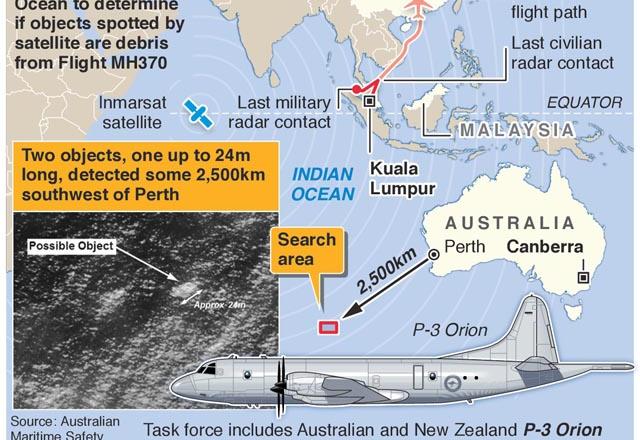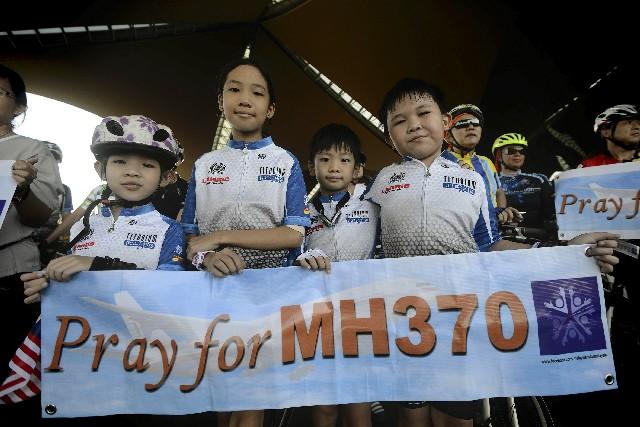You are here
Australia investigates ‘possible’ MH370 debris
By AFP - Mar 20,2014 - Last updated at Mar 20,2014

CANBERRA — Australia said Thursday that two objects — one estimated at 24 metres long — had been spotted in the Indian Ocean, the “best lead we have” in the search for a Malaysian passenger jet.
Four search aircraft had been dispatched to the remote area of the southern Indian Ocean to check whether grainy satellite photos indicated debris from missing Malaysia Airlines MH370, as relatives of passengers huddled anxiously awaiting news.
Australian Prime Minister Tony Abbott told parliament the images represented “new and credible information” but stressed that the link with flight MH370 had still to be confirmed.
“Following specialist analysis of this satellite imagery, two possible objects related to the search have been identified,” Abbott said.
The Malaysia Airlines Boeing 777, carrying 227 passengers and 12 crew, vanished in the early hours of March 8 after veering drastically off course over the South China Sea while en route to Beijing.
The reason for the deviation remains unknown although investigators believe it was the result of “deliberate action” by someone on board.
‘Awash with water’
Australian Maritime Safety Authority (AMSA) official John Young said the largest object sighted was assessed as being 24 metres long.
The two objects were in the southern Indian Ocean, about 2,500 kilometres southwest of Perth.
“The indication to me is of objects that are of a reasonable size and probably awash with water and bobbing up and down over the surface,” Young said, calling it, “the best lead we have right now”.
“But we need to get there, find them, see them, assess them, to know whether it’s really meaningful or not.”
A merchant ship was expected to arrive in the vicinity around 0700 GMT and the Australian naval vessel HMAS Success, which is capable of retrieving any debris, is some days away.
Abbott warned that it may turn out the objects “are not related to the search for flight MH370”.
The international search for the plane has been marked by numerous false leads, but the latest photos are the first solid clue since the search area was significantly expanded last weekend to take in a vast part of the Indian Ocean.
The expansion, based on sketchy radar and satellite data, involved two vast search corridors, stretching south into the Indian Ocean and north over South and Central Asia.
Most analysts had favoured the southern corridor, saying it was unlikely the airliner passed undetected over nearly one dozen countries in the northern arc.
The satellite photos were taken on Sunday, meaning the objects have been subjected to four days of ocean drift, making them a “logistical nightmare” to locate, said Australian Defence Minister David Johnston.
“We are in a most isolated part of the world. In fact it probably doesn’t get, if I can be so bold, more isolated,” Johnston told Sky News Australia.
Fundamental questions
Malaysian Transport Minister Hishammuddin Hussein stressed the urgent need to verify and “corroborate” what the images showed.
Experts said the fact that Abbott himself had released the information added weight to its credibility.
But David Kaminski-Morrow, air transport editor with aviation magazine Flight International, said the history of false starts meant the information will be “treated with extreme caution”.
“It’s the best lead simply because, with so little information, it’s effectively the only lead,” he said.
Malaysian authorities have been criticised for their handling of the investigation, especially by relatives of those on board who have complained of confusing or non-existent information.
Nearly two-thirds of the passengers were Chinese nationals.
China is paying “great attention” to the news from Australia, Beijing’s foreign ministry spokesman Hong Lei said in a statement.
“The Chinese side is ready to make relevant arrangements based on the latest updates,” he added, without elaborating.
There was a mixed reaction to the news among families gathered at a Beijing hotel, who for two weeks have been clinging to the slim hope that the plane might have secretly landed somewhere.
Some simply refused to countenance a crash scenario.
“My son is still alive. My son is still alive. I don’t believe the news,” cried Wen Wancheng, 63, as he pushed his way through a throng of reporters outside the hotel room used to update relatives.
Others cited the previous sightings that went nowhere.
“I am sick of hearing there is new information only for it to be dismissed later,” one man told AFP angrily.
In Malaysia, there had been chaotic, emotional scenes Wednesday when a group of tearful Chinese relatives tried to gatecrash the government’s tightly controlled daily media briefing at a hotel near Kuala Lumpur airport.
If the plane is found, fundamental questions will remain as to what caused it to crash.
Malaysia has asked the FBI to help recover data deleted from a flight simulator belonging to the missing plane’s chief pilot, Captain Zaharie Ahmad Shah, and removed from his home Saturday.
Zaharie, a 33-year veteran of the airline, was highly regarded by his peers. But suspicion has clouded the pilots since investigators concluded the plane’s communication systems were disabled manually before it changed course.
In his first on-camera comments on the mystery, US President Barack Obama, who is due to visit Malaysia next month, said he wanted anguished relatives to know Washington considers solving the riddle a “top priority”.
Related Articles
Thunderstorms and gale-force winds grounded the international air search for wreckage from Flight MH370 on Thursday, frustrating the effort yet again as Thailand reported a satellite sighting of hundreds of floating objects.
The search for missing Malaysia Airlines Flight MH370 could take years, US Navy officials suggested on Sunday, as search and rescue officials raced to locate the plane’s black box recorder days before its batteries are set to die.
A new analysis of satellite data indicates the missing Malaysia Airlines plane crashed into a remote corner of the Indian Ocean, Malaysian Prime Minister Najib Razak said Monday.


















